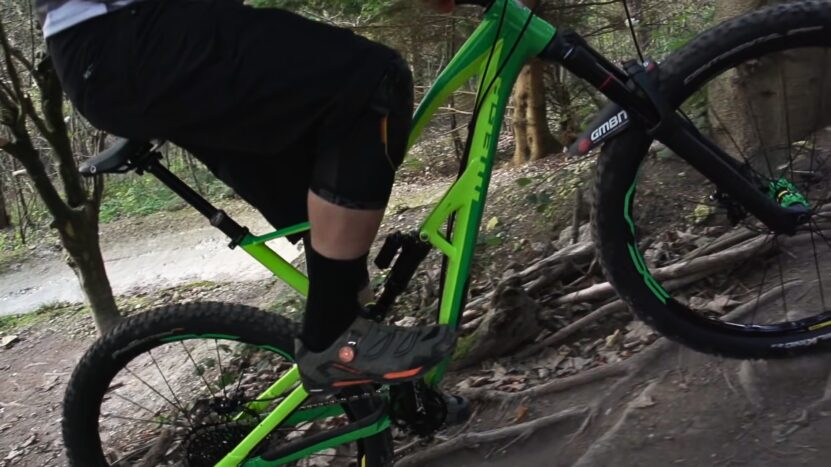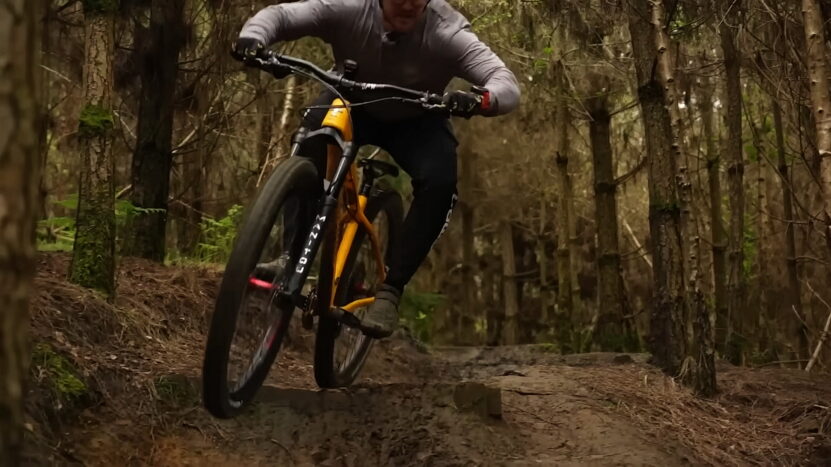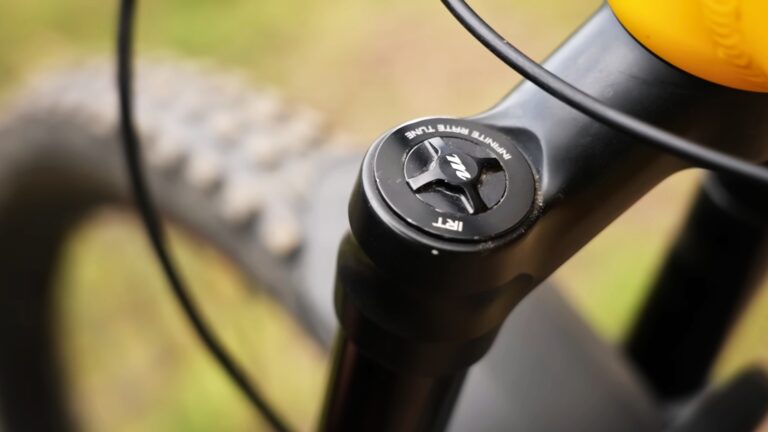Hardtail mountain bikes have a rigid frame with no rear suspension, while full-suspension mountain bikes have a frame with rear suspension.
Hardtails are generally lighter and cheaper than full suspensions, and they’re better for climbing and cross-country riding. Full suspensions are better for descending and technical riding.
Hardtail vs Full Suspension Key Differences
The main difference between a hardtail and full-suspension bicycles is the presence or absence of a rear shock absorber.
Hardtail bikes have no rear shock, while full-suspension bikes have a rear shock that helps to absorb bumps in the trail. This can provide a more comfortable ride, especially on rough terrain.
Full-suspension bikes are generally more expensive than hardtails, and they also tend to be heavier. Hardtails are often considered more versatile because they can be used for a wider variety of riding styles, but full-suspension bikes may be better suited for certain types of terrain or riding conditions.
Hardtail mountain bikes have a suspension fork in the front, but no rear suspension. This makes them lighter-weight and less expensive than full-suspension bikes, but they’re also not as comfortable on rough trails.
Full-suspension bikes have both a front and rear suspension, making them ideal for more aggressive riding or if you need extra comfort on long rides. They’re typically more expensive and heavier than hardtails, though.
Hardtails are lighter-weight and less expensive, but they’re not as comfortable on rough trails. Full-suspension bikes have both a front and rear suspension, making them ideal for more aggressive riding or if you need extra comfort on long rides. They’re typically more expensive and heavier than hardtails, though.
Full Suspension Bike vs Hardtail – Comparison
The debate between full-suspension mountain bikes and hardtails has been around for years, with no clear winner.
Both have their pros and cons, so it comes down to what you prioritize when choosing a bike. In this article, we’ll compare both types of bikes in terms of their geometry, weight, components, and price, to help you decide for yourself.
Geometry
When it comes to geometry, full-suspension bikes have a slight edge. They tend to have shorter chainstays and a lower bottom bracket height, which gives them better maneuverability and handling.
Hardtails, on the other hand, have longer chainstays and a higher bottom bracket height. This gives them more stability on rough terrain but can make them feel less agile.
Weight
In terms of weight, hardtails are typically lighter than full-suspension bikes. This is because they have fewer components and less complex suspension systems. Full-suspension bikes tend to be heavier, but this extra weight is offset by the fact that they’re more efficient at absorbing bumps and shocks.
Components
When it comes to components, full-suspension bikes typically have better quality components than hardtails. This is because they need to be able to withstand more wear and tear from the suspension system. Hardtails can get by with cheaper components since they don’t have to deal with as much stress.
Price
Finally, when it comes to price, hardtails are usually cheaper than full-suspension bikes. This is because they’re simpler to design and manufacture. Full-suspension bikes tend to be more expensive, but this extra cost is offset by the fact that they offer better performance and durability.
Is It Easier To Climb On A Hardtail Or Full Suspension?

Full-suspension bikes are good for climbing because they give you more traction and stability on the ground, making it easier to keep your balance and pedal efficiently. Hardtail bikes are lighter weight and require less maintenance, but can be more difficult to control on rough terrain.
Ultimately, it comes down to personal preference and what type of riding you’ll be doing most often. If you’re mostly riding on smooth trails, a hardtail bike might be a better choice.
But if you’re planning to tackle more challenging terrain, a full-suspension bike will give you the added control and comfort you need to make it to the top.
Are Hardtails Good For Big Jumps?
Hardtails are great for big jumps. They’re more nimble than full-suspension bikes, so you can make last-minute adjustments in the air. Plus, the lack of rear suspension means your wheels will stay firmly planted on the ground when you land.
Just be sure to pick a hardtail with beefy tires and forks to handle the extra abuse. Hardtails also tend to have shorter chainstays, which can give you a more responsive feel when jumping.
However, it is important to remember that hardtails are not necessarily the best choice for every rider or every jump. Some riders prefer the added stability and control of a full-suspension bike, and some jumps may be too big or too technical for a hardtail.
Are HardTails More Fun?
Yes, hardtails are more fun. They’re lighter, nimbler, and more responsive than full-suspension bikes. And since you’re not carrying around all that extra weight, you can go faster and farther. Hardtails also forces you to be a better rider since you can’t rely on the suspension to bail you out of tough situations.
Can You Ride Downhill On A Hardtail?

You can certainly ride downhill on a hardtail, but it’s not going to be as easy or as comfortable as riding a full-suspension bike. You’ll likely find yourself getting bounced around more, and you won’t have the same level of control.
That said, if you’re up for the challenge, it can be done! Just be prepared for a bit more of a workout. There are a few things you should keep in mind.
First, it’s important to have a bike that’s designed for the task. A cross-country hardtail probably won’t cut it – you’ll want something with beefier tires and maybe even some front suspension.
Second, you’ll need to be extra careful when it comes to choosing your lines. Hardtails can’t handle as much abuse as full-suspension bikes, so you’ll need to be mindful of rocks and other obstacles.
Finally, be prepared for a bit of a workout. Riding downhill on a hardtail requires more effort than riding a full-suspension bike, so you’ll need to be in good shape if you want to make it to the bottom without getting too tired.
Is Hardtails Good For Beginners?
If you’re new to mountain biking, you might be wondering if the full suspension is the way to go. After all, it seems like the most popular bikes on the trail are full suspension.
So, what is full suspension? Simply put, it’s a bike with both front and rear suspension. This means that there are shock absorbers on both the front fork and the rear triangle of the frame.
The main benefit of full suspension is that it helps to smooth out the ride. Rough terrain can be a challenge on a hardtail bike, but with full suspension, you’ll find it much easier to keep your wheels in contact with the ground. This results in better traction and a more comfortable ride.
Of course, there are some tradeoffs to consider with full suspension. The biggest one is cost – full suspension bikes tend to be more expensive than their hardtail counterparts.
Additionally, full-suspension bikes are typically heavier and can be more difficult to maneuver on tight trails. So, should you get a full-suspension bike? If you’re just getting started in mountain biking, a hardtail bike might be a better option.
However, if you have some experience and you’re looking for a more comfortable ride, full suspension could be the way to go. Ultimately, it’s up to you to decide what type of bike is best for your individual needs.
Can You Ride Trails On A Hardtail?
Yes, you can most certainly ride trails on a hardtail mountain bike. Many mountain bikers prefer hardtails for certain types of trail riding.
Hardtails tend to be lighter and more nimble than full-suspension bikes, making them ideal for climbing and cross-country riding.
And while they may not offer the same level of downhill performance as a full-suspension bike, a well-built hardtail can still handle plenty of rough terrains. So if you’re looking to do some serious trail riding, don’t count out a hardtail mountain bike.
Conclusion
If you’re mostly riding on smooth terrain, a hardtail bike may be a better choice. On the other hand, if you’re frequently riding on rougher terrain, a full-suspension bike will offer better performance and comfort.
Ultimately, it’s important to choose the bike that best suits your riding style and the type of terrain you’ll be riding on most often.

